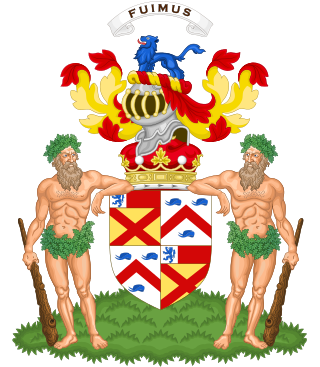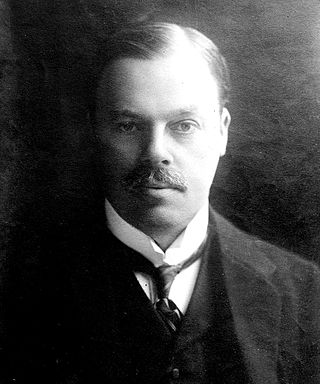
Marquess of Normanby is a title that has been created twice, once in the Peerage of England and once in the Peerage of the United Kingdom. The first creation came in 1694 in the Peerage of England in favour of John Sheffield, 3rd Earl of Mulgrave. He was a notable Tory politician of the late Stuart period, who served under Queen Anne as Lord Privy Seal and Lord President of the Council. In 1703 this first Marquess of Normanby was further honoured when he was made Duke of Buckingham and Normanby. These titles became extinct on the death of the 2nd Duke in 1735.

Viscount Chandos, of Aldershot in the County of Southampton, is a title in the Peerage of the United Kingdom and held by a branch of the Lyttelton family. It was created in 1954 for the businessman and public servant Oliver Lyttelton. He was the son of the politician and sportsman Alfred Lyttelton, eighth son of George Lyttelton, 4th Baron Lyttelton, whose eldest son, the 5th Baron Lyttelton, also succeeded his kinsman The 3rd Duke of Buckingham and Chandos as 8th Viscount Cobham in 1889. As of 2017 the title of Viscount Chandos is held by the first Viscount's grandson, the third Viscount, who succeeded his father in 1980. He lost his seat in the House of Lords after the passing of the House of Lords Act of 1999, which removed the automatic right of hereditary peers to sit in the upper chamber of Parliament. However, in 2000 he was given a life peerage as Baron Lyttelton of Aldershot, of Aldershot in the County of Hampshire, and was thus able to return to the House of Lords, where he now sits on the Labour benches. Lord Chandos is also in remainder to the viscountcy of Cobham and its subsidiary titles the barony of Cobham, the barony of Lyttelton, the barony of Westcote and the baronetcy of Frankley.

Marquess of Ailesbury, in the County of Buckingham, is a title in the Peerage of the United Kingdom. It was created on 17 July 1821 for Charles Brudenell-Bruce, 2nd Earl of Ailesbury.

Viscount Hood, of Whitley in the County of Warwick, is a title in the Peerage of Great Britain. It was created in 1796 for the famous naval commander Admiral Samuel Hood, 1st Baron Hood. He had already been created a Baronet, of Catherington, in the Baronetage of Great Britain on 20 May 1778, and Baron Hood, of Catherington in the County of Southampton, in the Peerage of Ireland in 1782.

Earl Erne, of Crom Castle in the County of Fermanagh, is a title in the Peerage of Ireland. It was created in 1789 for John Creighton, 2nd Baron Erne, who had earlier represented Lifford in the Irish House of Commons. He had already been made Viscount Erne, of Crom Castle in the County of Fermanagh, in 1781, also in the Peerage of Ireland, and sat from 1800 to 1828 as an Irish Representative Peer in the British House of Lords. The title of Baron Erne, of Crom Castle in the County of Fermanagh, was created in the Peerage of Ireland in 1768 for his father Abraham Creighton. The Earl was succeeded by his eldest son, the second Earl. On his death the titles passed to his nephew, the third Earl. He was an Irish Representative Peer from 1845 to 1885 and also served as Lord Lieutenant of County Fermanagh during the same period. In 1876 he was created Baron Fermanagh, of Lisnaskea in the County of Fermanagh, in the Peerage of the United Kingdom. This was to allow the Earls to sit in the House of Lords by right, rather than having to stand for election as Representative Peers. An earlier title of Baroness Fermanagh in the Peerage of Ireland was created for Mary Verney on 13 June 1792, but became extinct on her death on 15 November 1810.

Earl of Listowel is a title in the Peerage of Ireland. It was created in 1822 for William Hare, 1st Viscount Ennismore and Listowel, who had earlier represented Cork City and Athy in the Irish House of Commons.

Earl Granville is a title that has been created twice, once in the Peerage of Great Britain and once in the Peerage of the United Kingdom. It is now held by members of the Leveson-Gower family.

Viscount Rothermere, of Hemsted in the county of Kent, is a title in the Peerage of the United Kingdom. It was created in 1919 for the press lord Harold Harmsworth, 1st Baron Harmsworth. He had already been created a baronet, of Horsey in the County of Norfolk, on 14 July 1910, and Baron Rothermere, of Hemsted in the County of Kent, in 1914. Every holder of the titles has served as chairman of Daily Mail and General Trust plc. As of 2022 the titles are held by the first Viscount's great-grandson, the fourth Viscount, who succeeded his father in 1998.
Viscount Mills, of Kensington in the County of London, is a title in the Peerage of the United Kingdom. It was created on 22 August 1962 for the Conservative politician Percy Mills, 1st Baron Mills. He had already been created a Baronet, of Alcester in the County of Warwick, in the Baronetage of the United Kingdom on 1 July 1953, and as Baron Mills, of Studley in the County of Warwick, on 22 January 1957, also in the Peerage of the United Kingdom. As of 2017 the titles are held by his grandson, the third Viscount, who succeeded his father in 1988.
Viscount Colville of Culross, in the County of Perth, is a title in the Peerage of the United Kingdom. It was created on 15 July 1902 for the politician and courtier, Charles Colville, 10th Lord Colville of Culross. He had already been created Baron Colville of Culross, in the County of Perth, in 1885, also in the Peerage of the United Kingdom. As of 2018, the titles are held by his great-great-grandson, the fifth Viscount, who succeeded his father in 2010. The fourth Viscount was a judge and politician. Lord Colville of Culross was one of the ninety elected hereditary peers that remained in the House of Lords after the passing of the House of Lords Act 1999, and sat as a crossbencher.

Baron Churchill, of Wychwood in the County of Oxford, is a title in the Peerage of the United Kingdom and held by a branch of the Spencer family. It was created in 1815 for Lord Francis Spencer, younger son of the 4th Duke of Marlborough. He had previously represented Oxfordshire in Parliament.

Viscount Chilston, of Boughton Malherbe in the County of Kent, is a title in the Peerage of the United Kingdom. It was created in 1911 for the Conservative politician and former Home Secretary, Aretas Akers-Douglas. The title derives from Chilston Park, Akers-Douglas's country house in Kent. He was made Baron Douglas of Baads, in the County of Midlothian, at the same time, also in the Peerage of the United Kingdom. His son, the second Viscount, served as British Ambassador to Russia from 1933 to 1938. He was succeeded by his eldest surviving son, the third Viscount. As of 2010 the titles are held by the latter's first cousin once removed, the fourth Viscount, who succeeded in 1982. He is the grandson of the Hon. George Alexander Akers-Douglas, second son of the first Viscount.

Viscount Chelmsford, of Chelmsford in the County of Essex, is a title in the Peerage of the United Kingdom. It was created in 1921 for Frederic Thesiger, 3rd Baron Chelmsford, the former Viceroy of India. The title of Baron Chelmsford, of Chelmsford in the County of Essex, was created in the Peerage of the United Kingdom in 1858 for the first Viscount's grandfather, the lawyer and Conservative Sir Frederic Thesiger, who twice served as Lord Chancellor of Great Britain. Then following was the 2nd Baron, who gained the rank of general and was awarded. As of 2010 the titles are held by the first Viscount's great-grandson, the fourth Viscount, who succeeded his father in 1999.

Viscount Devonport, of Wittington in the County of Buckingham, is a title in the Peerage of the United Kingdom. It was created on 22 June 1917 for the Liberal politician and former Member of Parliament for Devonport, Hudson Kearley, 1st Baron Devonport. He had already been created a Baronet, of Wittington in the Parish of Medmenham in the County of Buckingham on 22 July 1908, and Baron Devonport, of Wittington in the County of Buckingham, on 15 July 1910. As of 2017 the titles are held by his grandson, the third Viscount, who succeeded his father in 1973.

Baron Sheffield is a title that has been created four times: once in the Peerage of England, twice in the Peerage of Ireland, and once in the Peerage of the United Kingdom.

Baron Sandhurst, of Sandhurst in the County of Berkshire, is a title in the Peerage of the United Kingdom. It was created on 28 March 1871 for the soldier Sir William Mansfield, Commander-in-Chief of India between 1865 and 1870 and Commander-in-Chief of Ireland between 1870 and 1875. He was the grandson of Sir James Mansfield, Solicitor-General and Chief Justice of the Common Pleas. Lord Sandhurst's eldest son, the second Baron, was a Liberal politician and also served as Governor of Bombay. On 1 January 1917 he was created Viscount Sandhurst, of Sandhurst in the County of Berkshire, in the Peerage of the United Kingdom. However, he had no surviving male issue and on his death in 1921 the viscountcy became extinct. He was succeeded in the barony by his younger brother, the third Baron. As of 2021 the title is held by the latter's great-grandson, the sixth Baron, who succeeded his father in 2002. He is a barrister and judge and was elected to a hereditary-peers' seat in the House of Lords in 2021.

Baron Burnham, of Hall Barn in the Parish of Beaconsfield in the County of Buckingham, is a title in the Peerage of the United Kingdom. It was created on 31 July 1903 for the influential newspaper magnate Sir Edward Levy-Lawson, 1st Baronet, owner of The Daily Telegraph. He had already been created a Baronet, of Hall Barn in The Parish of Beaconsfield in the County of Buckingham and of Peterborough Court in the City of London, in the Baronetage of the United Kingdom on 13 October 1892. Levy-Lawson was the son of Joseph Moses Levy, who acquired The Daily Telegraph only months after its founding.

Earl of Cavan is a title in the Peerage of Ireland. It was created in 1647 for Charles Lambart, 2nd Baron Lambart. He was made Viscount Kilcoursie, in the King's County, at the same time, also in the Peerage of Ireland. Lord Cavan was the son of Oliver Lambart, who had been elevated to the Peerage of Ireland as Lord Lambart, Baron of Cavan in the County of Cavan, in 1618.

Stanley Owen Buckmaster, 1st Viscount Buckmaster, was a British lawyer and Liberal Party politician. He was a Member of Parliament (MP) for most of the years from 1906 to 1915, when he was elevated to the peerage and served as Lord Chancellor under H. H. Asquith from 1915 to 1916.
Martin Stanley Buckmaster, 3rd Viscount Buckmaster was a British diplomat. He sat on the crossbenches in the House of Lords from 1974.
















